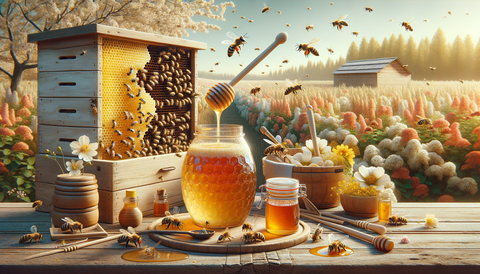Dear honey lovers, how many times have you stood in front of the supermarket shelf wondering: raw honey vs pasteurized, which one should I choose? At Apicoltura Regnani, we completely understand this dilemma. After generations devoted to the art of beekeeping, we've learned that the difference between these two types of honey goes far beyond just the production process.
When bees return to their hive at sunset, they bring with them nectar that will become liquid gold. But what happens next? This is where the paths of raw and pasteurized honey diverge, creating two products that are profoundly different in properties, flavor, and benefits.
What Is Raw Honey and Why It's So Special
Raw organic honey is exactly as the bees created it: pure, intact, and rich in all its natural components. At Apicoltura Regnani, we extract it from the combs through cold centrifugation, filtering only to remove any wax residue, never exceeding 40°C (104°F).
During our apiary tours, we often explain to visitors that raw honey preserves precious enzymes like diastase and invertase, which are responsible for transforming complex sugars. These enzymes, along with vitamins, minerals, and antioxidants, make our raw acacia honey a true wellness elixir.
Did you know? Raw honey contains over 200 different substances, including 22 amino acids, 27 minerals, and traces of pollen that give unique properties to each variety.
The Pasteurization Process: Pros and Cons
Honey pasteurization involves heating it to temperatures between 65°C and 78°C (149°F-172°F) for several minutes. This process, developed to ensure longer shelf life and product uniformity, has its advantages and disadvantages.
The benefits of honey pasteurization include:
- Extended shelf life
- Maintains liquid consistency longer
- Eliminates any present yeasts
- Uniform, crystalline appearance
However, heat destroys most beneficial enzymes and significantly reduces the content of heat-sensitive vitamins. It's like overcooking vegetables: they remain edible but lose much of their nutritional value.
Nutritional Properties: The Comparison That Makes the Difference
When we compare the properties of unpasteurized honey with heat-treated honey, the differences are substantial. Raw honey preserves:
- Active digestive enzymes that aid absorption
- Higher amounts of B-complex vitamins
- Natural antioxidants like flavonoids
- Traces of propolis with antibacterial properties
- Pollen that enriches the nutritional profile
In our experience, customers who switch to raw honey often report experiencing more complex and nuanced flavors. Our chestnut honey, for example, when unpasteurized maintains those bitter and tannic notes that make it unique, perfect for pairing with aged cheeses.
How to Recognize Raw Honey: Tips from Our Beekeepers
Recognizing unprocessed raw honey requires some experience, but there are unmistakable signs:
- Natural crystallization: Raw honey tends to crystallize over time, a sign of its authenticity
- Layering: You might notice slight separation between liquid and denser parts
- Variable color: Each batch may have different shades, reflecting the flowering season
- Presence of particles: Small grains of pollen or propolis are normal and beneficial
Grandmother's remedy: Our grandmothers used raw linden honey to prepare a calming infusion. They mixed a teaspoon of honey in warm water (never boiling!) with a few drops of lemon. A winter evening comfort that we still recommend to our customers today.
Storage and Use: Maximizing Honey's Benefits
Proper artisanal honey storage requires some care to maintain its properties intact:
- Store in a cool, dry place away from direct light
- Use glass or ceramic containers, never metal
- Avoid temperature fluctuations
- Never heat above 40°C (104°F) if you want to preserve the enzymes
A seasonal tip we always share: in spring, when acacia blossoms begin, it's the perfect time to stock up on raw honey. The bees are at their peak activity, and honey produced during this period has exceptional sensory characteristics.
For those interested in incorporating other hive products, we suggest pairing raw honey with our bee pollen, creating a perfect nutritional synergy to start your day with energy.
The Right Choice for Your Health
To the question "which honey to choose for health," our answer is clear: raw honey offers superior benefits. It's not just about taste, but about respecting the bees' millennia-old work and caring for our health.
Pasteurized honey certainly has its place in the market, especially for industrial uses or for those seeking a product that always remains liquid. However, for those seeking the benefits of natural honey in all their completeness, the choice can only be raw honey.
Apiary fact: Each hive produces an average of 20-30 kg of honey per year. Considering that bees must visit about 4 million flowers to produce 1 kg of honey, every teaspoon you taste represents the tireless work of hundreds of bees.
At Apicoltura Regnani, we continue to produce honey as our grandparents did, with patience and respect for the bees. The difference can be tasted in every spoonful, in every aroma that unfolds, in every benefit our body receives.
If you want to discover the true essence of Italian honey and personally experience the difference between raw and pasteurized honey, we invite you to explore our selection at apicolturaregnani.it. You'll find not only excellent single-flower honeys, but also plenty of tips for using them to their fullest and stories from our daily experience with bees.
Because choosing the right honey isn't just about taste: it's a small gesture that's good for you, the bees, and the environment we share.



